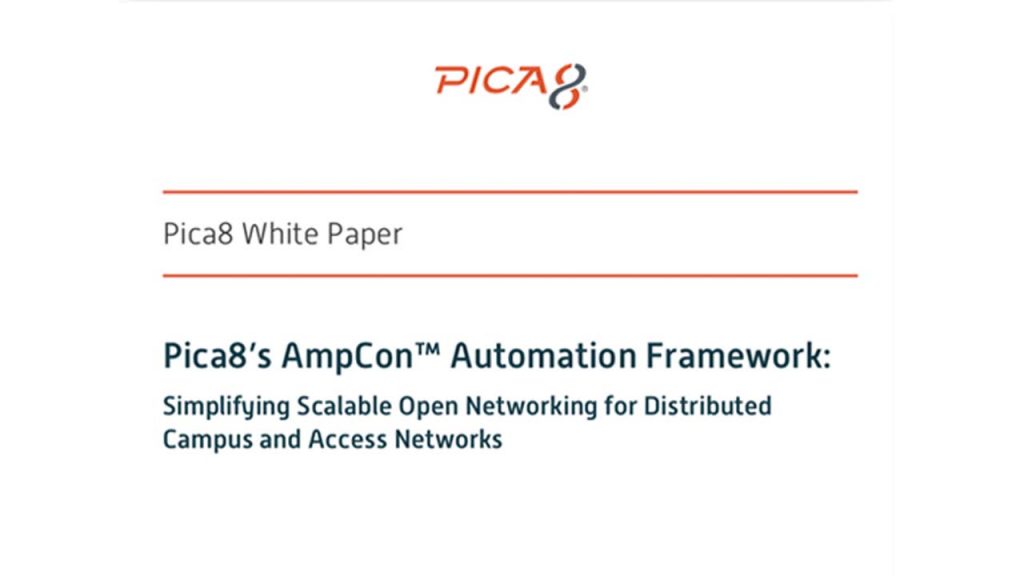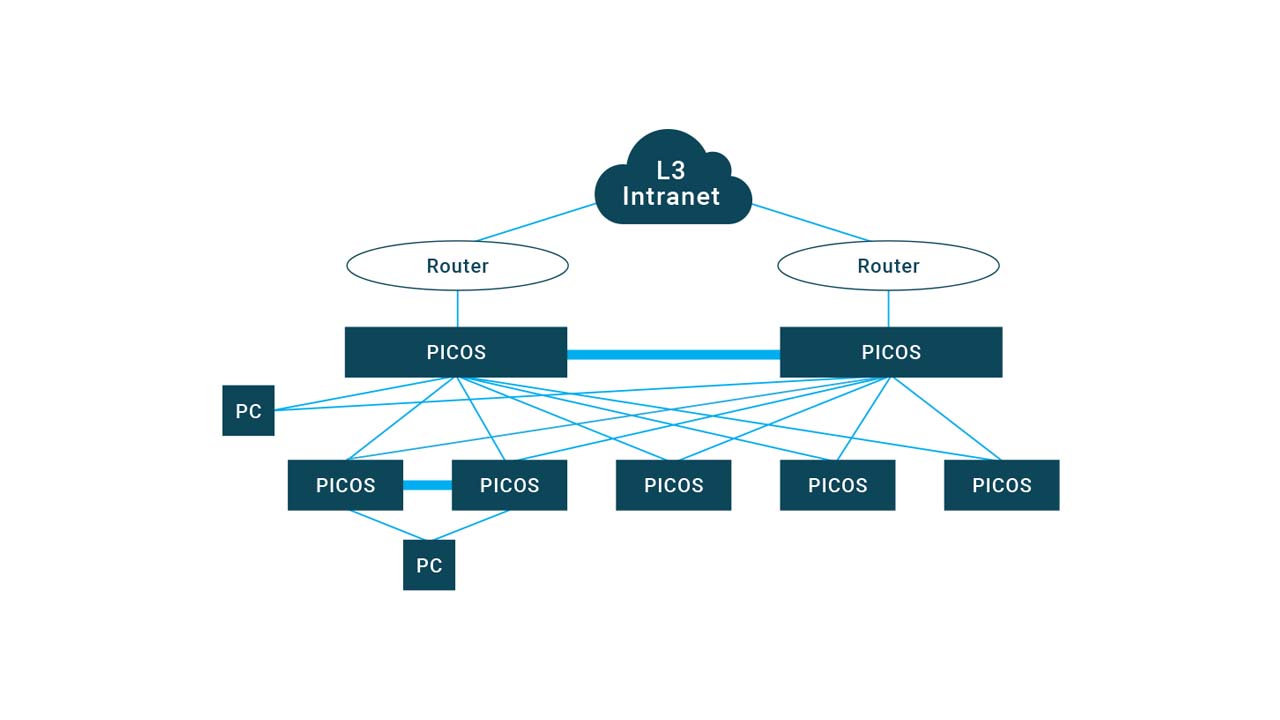Flexible Access-Network Automation
Because You Simply Don’t Have Enough Networking People
Enterprise, education, and government access networks need replacing – now.
Either they’re too old, or they can’t handle the flood of data and users coming from IoT, cloud services, wireless technology upgrades and mobile device proliferation. Almost every large, distributed campus and access network is due – if not overdue – for modernization.
![]()
Pica8’s AmpCon™ Framework
Built for large networks: Automate to lower opex, simplify management
![]()
Flexible Option for Ousting Incumbents
Low learning curve, highly interoperable, backward compatible, global support
![]()
Pica8’s
PICOS® NOS
Flexible intent-based networking with low-cost, open source, highly efficient NOS
The First Genuine Alternative to Cisco Access Networks
Pica8 now offers a proven, feature-comparable alternative to proprietary legacy automation products with its first, flexible access-network automation solution.
Back in 2012 Pica8 shipped PICOS, the first flexible Linux network operating system solution on a bare metal disaggregated switch. So, it’s safe to say no one understands flexible networking like we do. Pica8 now offers the world’s first automation framework explicitly designed for flexible access networks – AmpCon™ (short for Amplified Control). AmpCon presents a viable, market-proven alternative to the cloud of complexity that legacy vendors such as Cisco, Juniper, HPE, Aruba, Arista and the rest offer as network automation software.
Network automation tools are mandatory for any large-scale switch deployment. Data center networks – both legacy and flexible networking-based – are now fully automated, even though top-tier network engineers are available on site, constantly roaming the facilities. At the edge of enterprise networks, the world is vastly more diverse and complex. Access switch populations and configurations are far more complicated and fungible than in a data center, with no two access networks being remotely alike. Compounding the problem, no network support personnel are available for remote sites, nor are there out-of-band network management fabrics that would enable organizations to remotely manage their far flung branch offices, retail sites and schools.
In short, switch configurations are quite simple in the data center, making automation easy, while access switch configurations are not. This means network automation at scale is much harder to accomplish at the access edge but is even more necessary.
Until the advent of Pica8’s PICOS™ and AmpCon network automation framework, enterprises, schools, and government entities could only look to their existing vendors for new capabilities and upgrades to their access and distributed campus network infrastructure. But, just as happened in the data center, flexible networking has now arrived for the world of access networks via Pica8’s AmpCon — an automated, scalable, commercially proven alternative for deploying large numbers of switches. While it may be new to market, a number of Fortune 100 companies have already installed AmpCon, along with PICOS-powered flexible switches, in order to replace thousands of legacy Cisco switches with superior, cost-effective – and future-proofed — flexible network switches.
Simpler Deployment + Life-Cycle Management
AmpCon radically simplifies the turn-on and configuration of very large numbers of remote switches via its unique Push-Button Deployment capability. This feature allows even non-technical, non-programmer employees to use AmpCon’s Quick-Start Mode to fire up hundreds or thousands of switches at once using simple GUI-based English commands. The OpEx savings of this feature alone is almost incalculable given AmpCon essentially acts as a substitute for sending top – often non-existent — networking personnel to remote sites.
More key features and capabilities of AmpCon include:
- Web-based user interface – simple to learn and use
- Automated turn-on and configuration of all PICOS-powered switches
- Switch inventory
- Lifecycle license management for thousands of switches
- Built-in security (compliance checking, configuration validation, and more)
- Visibility of all remote switches from central location
- Centralized configuration upgrades and management
- AI-Ready future-proofed architecture
- Role-based access control
- Standard and configurable playbooks for network automation routines
- Detailed reporting
- Simple dashboards for at-a-glance status reports
- REST API support
-
Full access to a vast ecosystem of third-party networking tools
Benefits of Pica8’s AmpCon Framework
Most enterprises have a limited number of experienced network engineers, which makes automation a must. To get it they have had only two choices:
- Pay exorbitant rates for their legacy vendor’s network automation software
-
Build it themselves, such as with flexible tools like Ansible network automation scripts
Given limited resources, Option 2 is really not feasible. Changing legacy vendors is likewise difficult, given the learning curve involved – and the likelihood that the alternative won’t be a whole lot less expensive. The net result is, up to now, enterprises were more or less stuck with their legacy vendors.
Pica8’s AmpCon breaks this decidedly non-virtuous cycle, and, in the process, provides a number of key benefits, including:
Replaces legacy vendor-driven operational complexity with modern simplicity
Reduces operating expenses (OpEx) through simplified deployment and lifecycle management
Reduces the required number of scarce and expensive Tier-3 network support personnel
Eliminates human error in large-scale deployments and upgrades
Brings push-button deployment and configuration for thousands of remote access switches
Improves security and visibility – allowing policy changes on the fly to address security issues as they’re happening
Pica8 Helps Overcome the Old Barriers to Ousting Incumbents
Low Learning Curve
With AmpCon’s simple English commands, and other tools, we make the transition easy. There’s no easier way to get started than with Pica8 and AmpCon.
Full Backward Compatibility
Pica8’s PICOS easily integrates with legacy switches from Cisco, Juniper, Arista, HPE, Aruba , and others. That means you don’t have to swap out everything at once (although that’s certainly an option). Upgrade gradually, building by building, floor by floor, or however you best see fit.
We’ve Made Traditional Stacking Obsolete
Legacy vendors require you to have all the same switch models in a switch stack. Not so with Pica8’s PICOS functionality. You can now modernize wiring closets with the mix of switches that best fit your requirements. Even better, our new, simplified access architecture is more stable, offers more bandwidth, and is far more scalable than any legacy – vendor alternative in the market. We’ve even removed the 8-switch limitation on your existing stacks
NAC, VPN, Wireless Interoperability
Unlike the data center, the access edge is where users enter your network, so you need robust security solutions including network access control (NAC) and virtual private networks (VPNs) along with wireless networks. PICOS interoperates with solutions from major vendors including Cisco Identity Services Engine (ISE), Aruba ClearPass, the flexible source PacketFence project, and access points (APs) from any wireless network vendors.
Enterprise-Level Global Support
Pica8’s global partnerships with hardware vendors, including Dell EMC and Edgecore Networks, mean you can get support whenever and wherever you need it from a trusted global brand. For example, many customers already have support contracts with Dell EMC for laptops, servers and the like. Now you can get a global support contract under which Pica8 will handle any switch software issue 24×7, and Dell takes care of the hardware – anywhere, anytime

Benefits of Pica8’s PICOS NOS
Pica8’s PICOS provides other industry firsts that bring more benefits to even the largest Fortune 500 enterprise networks. But Pica8 is also a perfect fit for educational institutions as well as state and local governments, because the flexible network approach enables them to provide a superior network at a far lower cost compared to legacy vendors.
Flexible Intent-based Networking
Unique to Pica8, our CrossFlow™ — PICOS integrated OpenFlow — technology enables software-defined network (SDN)/OpenFlow traffic to flow over the same switch ports as operational Layer 2/Layer 3 traffic. This Pica8-only capability provides customers with a dedicated security control plane that also enables dynamic, granular data monitoring for performance analysis and network optimization, resulting in unmatched levels of network service flexibility, while paving the way for Open Intent-based Networking (OIBN).
Detect an intrusion in progress at a branch office? Simply send out a policy change to have the port the intruder is using reject or redirect the offending traffic (all without touching the switch access control lists (ACLs). Included as part of the PICOS license, CrossFlow provides non-proprietary IBN-style control and security, only delivered within the far-more cost-effective network model.
Slash CapEx and OpEx
Flexible network switches cost a fraction of legacy versions – and are based on the same underlying hardware. Software is likewise far less expensive. You certainly won’t get a full-fledged network automation framework like AmpCon from any legacy vendor. At the same time, AmpCon makes the network far easier to manage, slashing operational costs for years to come.
Highly efficient code base
With no legacy code to protect or unneeded features, our code has none of the bloat inherent in legacy networking software. You get a NOS that’s easier to work with and allows for far faster fault tracing and remediation.
Flexible source tools
Pica8’s flexible networking approach shows up enterprises to the vibrant ecosystem of flexible source networking tools. You’ll find useful tools that aren’t difficult to deploy and use, such as Zabbix for network monitoring. And for network automation, there’s Ansible and Ansible Tower, with their vast libraries of pre-built automation scripts.


